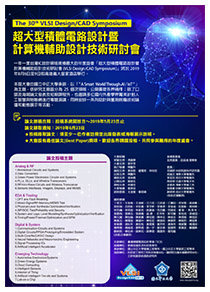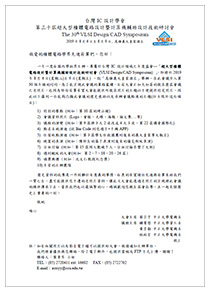Oral 9: Data Converter, RF/mm-Wave Circuits, and High-Speed Building Blocks
Session Chair: Wei-Bin Yang (Tamkang University) and Chun-Hsing Li (National Tsing Hua University)Date: Aug. 8 (Thu.), 2019
Time: 11:30 – 12:42
Room: 6F 樂廳
| 順序 | 口頭報告論文 |
| 1 | 11:30 – 11:42 (S0204) Monolithic CMOS Microwave Heater with Programmable Thermostat Function Tzu-Yu Tseng, Hsiao-Chin Chen and Jenq-Shiou Leu National Taiwan University of Science and Technology Abstract: A monolithic CMOS microwave heater with programmable thermostat function is implemented for thermotherapy. To achieve microwave heating, the heater adopts a 2.4-GHz oscillator to generate the microwave and uses an amplifier with LC resonance load to enhance the signal strength. The load inductor is employed as the heat applicator as large electrical field would be created around it. The microwave heater is then integrated with temperature sensors, a 11-bit SAR-ADC and a comparator to achieve the thermostat function. Dissipating the power of 145 mW, the amplifier delivers the output power of 13.2 dBm. The temperature sensors achieve sensing range from 20 ℃ to 50 ℃, with the sensitivity of 47 mV/℃. When 427mg of agar phantoms is placed above the heater, it can be heated up by 1 ℃ with 0.1 ℃ accuracy when the thermostat function is activated. |
| 2 | 11:42 – 11:54 (S0146) Device Area Allocation for Yield Optimization in Integrated Circuits Poki Chen and Ahmad Shahid Bhatti National Taiwan University of Science and Technology Abstract: There are very few papers focusing on integrated circuit layout instead of design. Most of them are devoted to the generation of layout patterns to cancel the error caused by systematic mismatch. There are really few papers dealing with random mismatch especially by allocating proper areas to critical devices for yield optimization. Area allocation strategies for yield optimization are proposed for some important analogue circuits in this paper. To demonstrate the performance, not only full-coverage simulations but also theoretical analyses are revealed. A test chip of the most representative circuit, R-2R ladder network, has been realized in a TSMC 0.35 µm standard CMOS process to verify the excellence of the proposed area allocation strategy. To further ease the burden of analog IC designers and layout engineers, a rule of thumb based on device weights for area allocation with at least close-to-optimum yield is also presented. |
| 3 | 11:54 – 12:06 (S0122) A 14-bit Low Power 2-MS/s SAR ADC with Residue Oversampling Sheng-Wen Huang and Soon-Jyh Chang National Cheng Kung University Abstract: This paper presents a 14-bit successive-approximation register (SAR) analog-to-digital converter (ADC), which adopts Residue Oversampling and Detect-and-Skip (DAS) techniques for high resolution and low power requirements. The proof-of-concept prototype was fabricated in TSMC 40-nm CMOS technology. At 2-MS/s sampling rates, the measured peak SNDR is 64.94dB without calibration. With a 0.03 standard deviation at each unit capacitor, static performance shows that INL and DNL are +1.25/-0.80 and +1.05/-0.97, respectively. |
| 4 | 12:06 – 12:18 (S0060) A 10-Gb/s Equalizer with Digital Adaptation Jui-Cheng Hsiao, Dai-En Jhou, Hsiu Hsien Ting, and Tai-Cheng Lee National Taiwan University Abstract: An equalizer using a digital adaptive algorithm is proposed to minimize hardware cost. The proposed algorithm uses two analog reference levels to detect the low-frequency and high-frequency components of the input amplitude, respectively. By monitoring the two reference levels, the proposed equalizer can tune its high-frequency gain to compensate the channel loss appropriately. This work has been fabricated in a 40-nm process, and the equalizer core circuit occupies 0.014 mm2 and consumes 10 mW from a 1-V supply. |
| 5 | 12:18 – 12:30 (S0003) A Flip-Chip-Assembled W-Band Receiver in 90-nm CMOS and IPD Technologies Te-Yen Chiu, Wan-Ting Hsieh, and Chun-Hsing Li National Tsing Hua University Abstract: A flip-chip-assembled W-band receiver composed of a 90-nm CMOS chip and an integrated-passive-device (IPD) carrier is presented in this work. The chip which integrates a low-noise amplifier (LNA), a single-sideband mixer, a frequency doubler (FD), and a wide-band variable-gain amplifier (VGA), is flip-chip packaged to the IPD carrier through a low-loss interconnect. Experimental results show that the proposed packaged receiver can provide a variable gain from 11.3 to 48.2 dB while having an input 1-dB compression point from -43.7 to -29 dBm as the RF frequency is 90 GHz. The IF bandwidth and minimum noise figure can be 1.0 GHz and 7.8 dB, respectively. The proposed receiver only consumes 73.9 mW from a 1.2-V supply. To the best of authors’ knowledge, this is the first W-band CMOS receiver assembled on an IPD carrier reported thus far. |
| 6 | 12:30 – 12:42 (S0063) An S-Band CMOS Mixer-First Single-RF-Port Duplexing FMCW Radar Hao-Chung Chou (1), Chun-Chieh Peng (1), Yu-Jiu Wang (2) ,and Ta-Shun Chu (1) (1) National Tsing Hua University and (2) Tron Future Tech Inc. Abstract: A mixer-first single-RF-port duplexing RF frontend is proposed and implemented for frequency-modulated continuous-wave (FMCW) radar applications in this paper. The RF frontend is a bidirectional simultaneous frequency up-and-down converter. Equations of basic parameters of the frontend are derived to provide design criteria. The proposed radar architecture has been evaluated with an S-band (3.3-3.6 GHz) FMCW radar. The radar chip is fabricated in a 65nm CMOS process, and it consumes 190 mW of DC power under 1.2V supply. A wireless distance measurement has verified the function of the radar chip. |
指導單位:
教育部資訊及科技教育司
主辦單位:
臺灣積體電路設計學會
承辦單位:
國立中正大學電機工程學系
國立中正大學資訊工程學系
協辦單位:
科技部工程司工程科技推展中心
國研院台灣半導體研究中心
中國電機工程學會
智慧聯網整合推動聯盟中心
中央研究院資訊科學研究所
贊助單位:
聯發科技股份有限公司
日月光半導體製造股份有限公司
威鋒電子股份有限公司
奇景光電股份有限公司
荷蘭商益華國際電腦科技(股)公司台灣分公司
台灣新思科技股份有限公司
財團法人工業技術研究院
瑞昱半導體股份有限公司
聯詠科技股份有限公司
鈦思科技股份有限公司
台灣是德科技股份有限公司
和澄科技股份有限公司
愛爾蘭商明導股份有限公司台灣分公司
一元素科技股份有限公司
力旺電子股份有限公司
博鑫醫電股份有限公司
群聯電子股份有限公司
晶心科技股份有限公司




